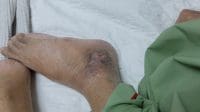Pressure ulcers are painful, life-threatening, and expensive —with medical costs of up to $11 billion annually in the United States. Medicare and private insurers know they’re largely preventable and have stopped reimbursing healthcare organizations for costs related to pressure ulcers not present on admission. Obviously, the pressure is on to reduce pressure ulcers.
The big picture
Pressure ulcers are:
- a source of pain and disfigurement that can interfere with activities of daily living
- strongly associated with mortality in acute, post-acute, and long-term care settings
- a major contributor to increased length of stay
- responsible for millions of dollars in litigation claims.
Care breakdown = skin breakdown
Like other challenging patient-care issues, pressure ulcer care is complicated and involves many different components. Also, with the ever-increasing number of obese, diabetic, and elderly patients, pressure ulcer rates are on the rise. So whether we like it or not, this issue will be with us for a long time.
Treatment of pressure ulcers traditionally has been a focus of nursing care. In Notes on Nursing (1859), Nightingale wrote, “If he has a bedsore, it’s generally not the fault of the disease, but of the nursing.” Pressure ulcer guidelines have been disseminated by various organizations since the 1990s, with the latest guidelines from the National Pressure Ulcer Advisory Panel published in 2014. So why aren’t the recommendations woven into our care processes by now? Clearly, they’re not sticking, because pressure ulcer rates remain high.
Changing approach, changing practice
Have you seen the Veterans Health Administration Pressure Ulcer Prevention Handbook? It’s 41 pages of WOW! To judge for yourself, visit www.va.gov/vhapublications/ViewPublication.asp?pub_ID=2422.
Like many other excellent tools I’ve researched and papers I’ve read, such as those by leaders at Ascension Health and Kaiser Permanente, it’s clear that “suggestions” don’t change practice.
When I spoke to Veterans Affairs nursing leaders about their work in the vulnerable population they serve, one said, “Education is important. We often sound like a broken record. We say it over and over and over again, and at some point, it sticks.” Guidelines and policies aren’t suggestions; they are standards. By now, mandates have replaced recommendations, reinforcing the need for education when guidelines are first released so that they’re adopted by clinicians.
If pressure ulcers were apples
I’m all about making learning fun while making a point—especially when it comes to pressure ulcers.
A great example comes from a recent article I read in Wound Care Advisor, where the author explains a three-part inservice program called “If pressure ulcers were apples.” It consists of information about pressure ulcers and their staging, a crossword puzzle with pressure-ulcer related clues and answers, and an interactive “Minute-to-win-it” game to reinforce the didactic material. (This material was adapted from Patricia Turner’s work, “Apples to Ulcers: Tips for Staging Pressure Ulcers.”) To read about the program so you can replicate it in your
organization, visit http://woundcareadvisor.com/if-pressure-ulcers-were-apples-a-fun-inservice-program/.
Practices that work: Bundles and benchmarks
Bundling interventions into care sets, such as Ascension Health’s SKIN bundle (Surfaces, Keep the patients turning, Incontinence management, Nutrition) and the VA SKIN (VASKIN) bundle has proven successful over time. When using these in combination with credible data use, such as that from the National Database of Nursing Quality Indicators and the Hill-Rom International Pressure Ulcer Prevalence Study, organizations are seeing positive results.
Successful interventions share a few common attributes—standardized care processes and products, a system-wide commitment in capital dollars for proper equipment, collaboration across disciplines, wound care nursing consults, consistent patient assessment, and nutritional support.
So what are you doing that works? Let’s spread the word on what’s working and stop what’s not. With the pressure that’s on us, we have no time to waste. Our patients deserve nothing less.
On another note, Happy National Nurses Week to all our readers. We salute you!
Lillee Gelinas, MSN, RN, FAAN
Editor-in-Chief
lgelinas@healthcommedia.com


















